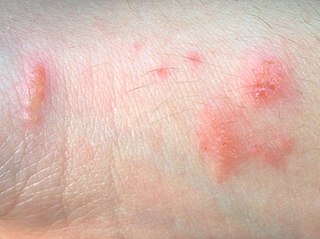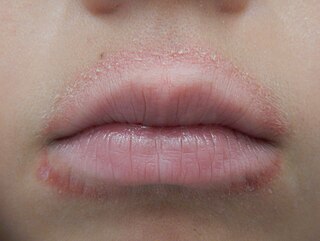
Dermatitis is a term used for different types of skin inflammation, typically characterized by itchiness, redness and a rash. In cases of short duration, there may be small blisters, while in long-term cases the skin may become thickened. The area of skin involved can vary from small to covering the entire body. Dermatitis is also called eczema but the same term is often used for the most common type of skin inflammation, atopic dermatitis.

Toxicodendron radicans, commonly known as eastern poison ivy or poison ivy, is a species of allergenic flowering plant. It has numerous subtaxons and forms both vines and shrubs. Despite its common name, it is not a true ivy, but rather a member of the cashew and pistachio family Anacardiaceae. It is different from western poison ivy, Toxicodendron rydbergii, and resembles a number of species.

Urushiol is an oily mixture of organic compounds with allergenic properties found in plants of the family Anacardiaceae, especially Toxicodendronspp., Comocladia spp. (maidenplums), Metopium spp. (poisonwood), and also in parts of the mango tree and the fruit of the cashew tree.

Contact dermatitis is a type of acute or chronic inflammation of the skin caused by exposure to chemical or physical agents. Symptoms of contact dermatitis can include itchy or dry skin, a red rash, bumps, blisters, or swelling. These rashes are not contagious or life-threatening, but can be very uncomfortable.
Antipruritics, abirritants, or anti-itch drugs, are medications that inhibit itching . Itching is often associated with sunburns, allergic reactions, eczema, psoriasis, chickenpox, fungal infections, insect bites and stings like those from mosquitoes, fleas, mites, and contact dermatitis and urticaria caused by plants such as poison ivy or stinging nettle. Itching can also be caused by chronic kidney disease and related conditions.

Cutaneous larva migrans is a skin disease in humans, caused by the larvae of various nematode parasites of the hookworm family (Ancylostomatidae). The parasites live in the intestines of dogs, cats, and wild animals; they should not be confused with other members of the hookworm family for which humans are definitive hosts, namely Ancylostoma duodenale and Necator americanus.

Cefaclor, sold under the trade name Ceclor among others, is a second-generation cephalosporin antibiotic used to treat certain bacterial infections such as pneumonia and infections of the ear, lung, skin, throat, and urinary tract. It is also available from other manufacturers as a generic.

Urushiol-induced contact dermatitis is a type of allergic contact dermatitis caused by the oil urushiol found in various plants, most notably sumac family species of the genus Toxicodendron: poison ivy, poison oak, poison sumac, and the Chinese lacquer tree. The name is derived from the Japanese word for the sap of the Chinese lacquer tree, urushi. Other plants in the sumac family also contain urushiol, as do unrelated plants such as Ginkgo biloba.

Allergic contact dermatitis (ACD) is a form of contact dermatitis that is the manifestation of an allergic response caused by contact with a substance; the other type being irritant contact dermatitis (ICD).

Tetrazepam is a benzodiazepine derivative with anticonvulsant, anxiolytic, muscle relaxant and slightly hypnotic properties. It was formerly used mainly in Austria, France, Belgium, Germany and Spain to treat muscle spasm, anxiety disorders such as panic attacks, or more rarely to treat depression, premenstrual syndrome or agoraphobia. Tetrazepam has relatively little sedative effect at low doses while still producing useful muscle relaxation and anxiety relief. The Co-ordination Group for Mutual Recognition and Decentralised Procedures-Human endorsed the Pharmacovigilance Risk Assessment Committee (PRAC) recommendation to suspend the marketing authorisations of tetrazepam-containing medicines across the European Union (EU) in April 2013. The European Commission has confirmed the suspension of the marketing authorisations for Tetrazepam in Europe because of cutaneous toxicity, effective from the 1 August 2013.
Serum sickness in humans is a reaction to proteins in antiserum derived from a non-human animal source, occurring 5–10 days after exposure. Symptoms often include a rash, joint pain, fever, and lymphadenopathy. It is a type of hypersensitivity, specifically immune complex hypersensitivity. The term serum sickness–like reaction (SSLR) is occasionally used to refer to similar illnesses that arise from the introduction of certain non-protein substances, such as penicillin.

Dermatitis herpetiformis (DH) is a chronic autoimmune blistering skin condition, characterised by intensely itchy blisters filled with a watery fluid. DH is a cutaneous manifestation of coeliac disease, although the exact causal mechanism is not known. DH is neither related to nor caused by herpes virus; the name means that it is a skin inflammation having an appearance similar to herpes.
Dogs are susceptible to allergies much like their human companions. Most allergies occur in dogs over 6 months old. A dog that is repeatedly exposed to a particular allergen becomes sensitized to it, and the immune system overreacts to a subsequent exposure, most commonly manifesting in the form of skin irritation. Some of the signs are redness, itching, hair loss, and recurring skin infections from the irritation. The dog may be more prone to scratching and licking at the irritated site, further exacerbating the problem.
Drug-induced pruritus is itchiness of the skin caused by medication, a pruritic reaction that is generalized.

Alcyonidium diaphanum, commonly called the sea-chervil, is a species of bryozoan found in the North Atlantic. It can cause a rash known as "Dogger Bank itch" when handled for prolonged periods.
Protein contact dermatitis is a cutaneous condition, and was a term originally used to describe an eczematous reaction to protein-containing material in food handlers. Usually affecting the hands or forearms, it manifests clinically as a subacute or chronic dermatitis that recurs frequently over time. Niels Hjorth and Jytte Roed-Petersen coined the phrase "protein contact dermatitis" in 1976.

Poison ivy is a type of allergenic plant in the genus Toxicodendron native to Asia and North America. Formerly considered a single species, Toxicodendron radicans, poison ivies are now generally treated as a complex of three separate species: T. radicans, T. rydbergii, and T. orientale. They are well known for causing urushiol-induced contact dermatitis, an itchy, irritating, and sometimes painful rash, in most people who touch them. The rash is caused by urushiol, a clear liquid compound in the plant's sap. They are variable in appearance and habit, and despite its common name, it is not a "true" ivy (Hedera), but rather a member of the cashew and pistachio family (Anacardiaceae). T. radicans is commonly eaten by many animals, and the seeds are consumed by birds, but poison ivy is most often thought of as an unwelcome weed.

Nickel allergy is any of several allergic conditions provoked by exposure to the chemical element nickel. Nickel allergy often takes the form of nickel allergic contact dermatitis (Ni-ACD), a form of allergic contact dermatitis (ACD). Ni-ACD typically causes a rash that is red and itchy and that may be bumpy or scaly. The main treatment for it is avoiding contact with nickel-releasing metals, such as inexpensive jewelry. Another form of nickel allergy is a systemic form: systemic nickel allergy syndrome (SNAS) can mimic some of the symptoms of irritable bowel syndrome (IBS) and also has a dermatologic component.

Lip licker's dermatitis is a type of skin inflammation around the lips due to damage by saliva from repetitive lip licking and is classified as a subtype of irritant contact cheilitis. The resulting scaling, redness, chapping, and crusting makes a well-defined ring around the lips. The rash may extend as far as the tongue can reach and usually does not occur at the corners of the mouth. It commonly occurs during winter months but some people can have it year-round if lip licking is a chronic habit.

(2-Hydroxyethyl) dimethylsulfoxonium chloride is an organic compound with the formula [HOCH2CH2S(O)(CH3)2]+Cl−. It is a sulfonium ion with a chloride counterion. The cation has been isolated from sea chervils and sea sponges. It causes the Dogger Bank itch.













